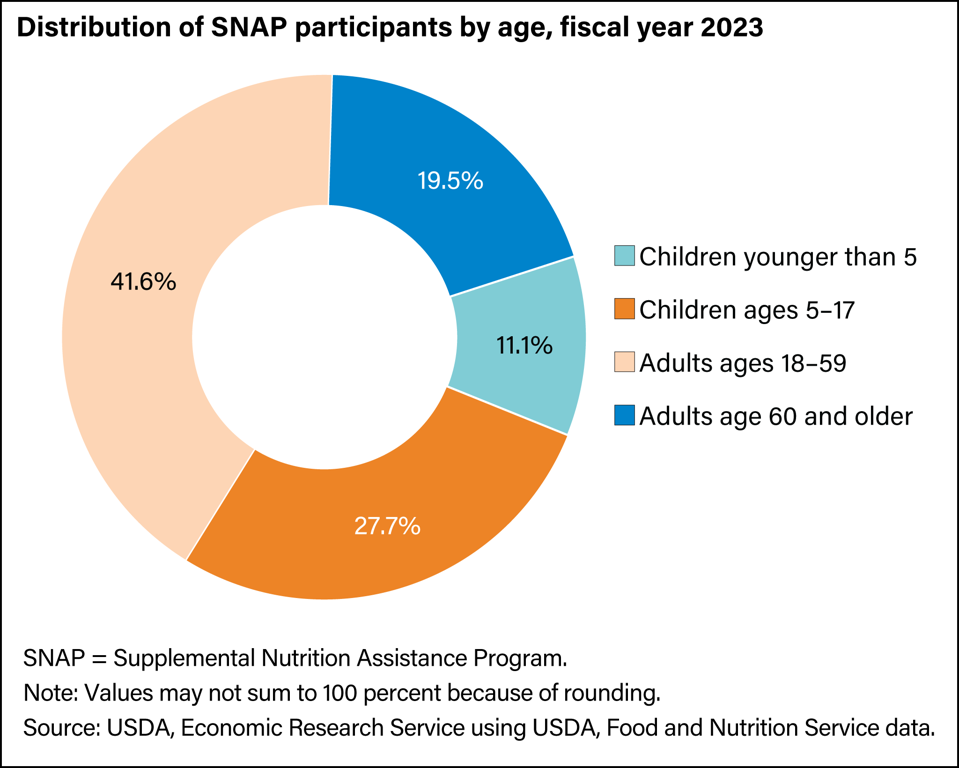The Supplemental Nutritional Aid Program and subsidies for health insurance through the Affordable Care Act are now done. There’s been no negotiation as congressional Republicans insist on a straight extension of a budget that has no provision for either program.
As for Saturday, November 1, SNAP assistance will be cut off. It means a brutal shutdown for many people in or near poverty and ultimately an impact on the economy.
Silly Claims And Facts
Someone on X claimed that SNAP spending almost doubled when Biden was president. Total spending on the program had been falling since the $107.1 billion in 2013, after a period of sharp growth following the Great Recession. Total spending in 2019 fell to $74 billion. Then it jumped to $132.2 billion in 2021. That was set by Congress and signed by then-President Trump because of the pandemic, after which it started falling, dropping to $100.3 billion in 2024, which would be the 2024 federal fiscal budget — under Biden.
There is outrage over roughly 42 million people being on the SNAP program. Is that reasonable? That is about 12% of the population As demographic analyses go, seeing a tenth of the population in a low part of the economic order doesn’t seem outrageous. When the technical poverty rate in the country was 10.6% in 2024 and 11.1% in 2023 and there has been growing evidence of economic and labor weakness, the percentage doesn’t seem unrealistic.
According to the US Department of Agriculture, 73% of households receiving SNAP have gross monthly incomes at or below 100% of the poverty level, while 86% of all SNAP benefits go to households with gross monthly income at or below the poverty level. Then, 51% of benefits go to those with gross monthly incomes at or below 50% of the poverty rate. The 27% of households with a gross monthly above the poverty level receive 14% of all benefits.
More Details
These numbers mean that many households receiving SNAP benefits have income — mostly Social Security (33% of SNAP households received an average of $1,096 monthly). Twenty-eight percent of households had earnings from work (average $1,548 per month) or Supplemental Security Income (SSI) for those who cannot work.
Only 4% of SNAP households received General Assistance ($380 monthly on average) and 3% received Temporary Assistance for Needy Families ($573 monthly).
Then there is an assumption that many or most recipients are able-bodied adults that could work and essentially living on the dole. Is there some fraud? Certainly, as with every single program everywhere. Much of that is theft of cards and benefits, large-scale criminal scamming, and fraud by some stores that receive payments.
Here’s the breakout of the demographics.
In 2023, 58.4% of recipients were children younger than 5 (11.1%), children ages 5 to 17 (27.7%), and adults age 60 and older (19.5%). Some significant percentage of the adults 18 to 59 are disabled. Here is another breakout of SNAP recipients by subgroup which shows that disabled group, among others.
And many households counted as receiving SNAP benefits are so because some residents — like children or seniors or adults with a disability — live in that household. Not all residents necessarily receive the benefits.
How much is the luxurious subsidies that many get? The average SNAP household receives $332 per month, or $177 per person based on an average household size of 1.9 people. Households with children get $574 on average because the larger average household size is 3.3 people. For those households, the average benefit per person was $174.
Economic Fallout
Besides a dangerous blow to many millions, it will have implications for the economy. People who have little channel such federal benefits into local companies. They need utilities, food, rent, household products. When people are desperate and hungry, will they keep spending money in other categories?
And what happens to the even greater economy? If a country cuts loose the most impoverished, it’s only time until they push off others who don’t make enough. The people who are paid a pittance to do work necessary for corporations that externalize their expenses by not paying people enough to live on, by outsourcing jobs overseas, by planning broad replacements of workers with artificial intelligence and automation. Eventually, SNAP qualification may not seem so far removed for many who have thought themselves safe.

